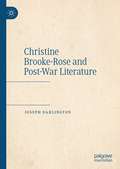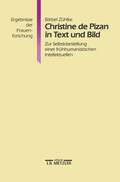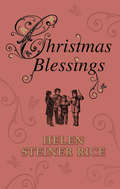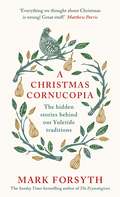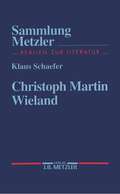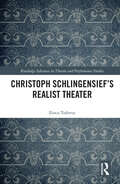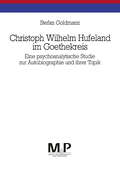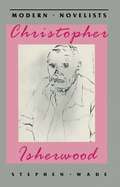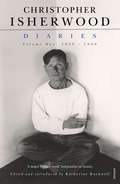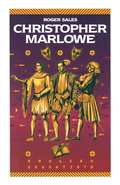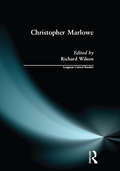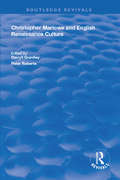- Table View
- List View
Christine Brooke-Rose and Post-War Literature
by Joseph DarlingtonThis book utilizes archive research, interviews and historical analysis to present a comprehensive overview of the works of Christine Brooke-Rose. A writer well-known for her idiosyncratic and experimental approaches to the novel form; this work traces her development from her early years as a social satirist, through her space-aged experimentalism in the 1960s, to her later poststructuralism and interest in digital computing and genetics. The book gives an overview of her writing and intellectual career with new archival research that places Brooke-Rose’s work in the context of the historically important events in which she was a participant: Bletchley Park codebreaking in the Second World War, the events in Paris during May 1968, the dawning of the internet and the rise of poststructuralism. Joseph Darlington begins with Brooke-Rose’s first novels written in the late 1950s of social satire, studies her experimental phase of writing and finally illuminates her unique approach to autobiography, arguing for reevaluating this interdisciplinary author and her contribution to poststructuralism, life writing and post-war literature.
Christine de Pizan: A Casebook
by Barbara K. AltmannChristine de Pizan wrote voluminously, commenting on various aspects of the late-medieval society in which she lived. Considered by many to be the first French woman of letters, Christine and her writing have been difficult to place ever since she began putting her thoughts on the page. Although her work was neglected in the eighteenth and nineteenth century, there has been a eruption of Christine studies in recent decades, making her the perfect subject for a casebook. This volume serves as a useful guide to contemporary research exploring Christine's life and work as they reflected and influenced her socio-political milieu.
Christine de Pizan: A Casebook
by Barbara K. Altmann Deborah L. McGradyChristine de Pizan wrote voluminously, commenting on various aspects of the late-medieval society in which she lived. Considered by many to be the first French woman of letters, Christine and her writing have been difficult to place ever since she began putting her thoughts on the page. Although her work was neglected in the eighteenth and nineteenth century, there has been a eruption of Christine studies in recent decades, making her the perfect subject for a casebook. This volume serves as a useful guide to contemporary research exploring Christine's life and work as they reflected and influenced her socio-political milieu.
Christine de Pizan in Text und Bild: Zur Selbstdarstellung einer frühhumanistischen Intellektuellen. Ergebnisse der Frauenforschung, Band 36 (Ergebnisse der Frauenforschung)
by Bärbel ZühlkeDieser Band beleuchtet in interdisziplinärer Breite die Selbstwahrnehmung einer schreibenden Frau, die sich selbst als Autorin in der Nachfolge Dantes versteht.
Christine's Vision (Routledge Revivals)
by Christine de PizanOriginally published in 1993, this book offers a translation of Christine de Pizan's Christine's Vision, as translated by Glenda K. McLeod. One of France's first professionl writers, Christine de Pizan wrote a large and remarkable body of work, distinguished not only for its variety and quality but also for its unusual blend of introspective and public commentary. As Christine's Vision makes clear, Christine sensed the similarities between her fate and France's and felt a close bond with her adopted land.
Christine's Vision (Routledge Revivals)
by Christine de PizanOriginally published in 1993, this book offers a translation of Christine de Pizan's Christine's Vision, as translated by Glenda K. McLeod. One of France's first professionl writers, Christine de Pizan wrote a large and remarkable body of work, distinguished not only for its variety and quality but also for its unusual blend of introspective and public commentary. As Christine's Vision makes clear, Christine sensed the similarities between her fate and France's and felt a close bond with her adopted land.
Christmas Blessings
by Helen Steiner RiceWhatever the celebration, whatever the day, whatever the occasion, Helen Steiner Rice possessed the ability to express the appropriate feeling for that particular moment in time. Her positive attitude, her concern for others, and her love of God are identifiable threads woven into her life and her work. The role Christmas plays in an individual's life depends on the interpretation of the event and varies from person to person and family to family. In this collection of verses Helen Steiner Rice simply and touchingly reaffirms the nature of faith and hope.
A Christmas Cornucopia: The Hidden Stories Behind Our Yuletide Traditions
by Mark ForsythThe unpredictable origins and etymologies of our cracking Christmas customsFor something that happens every year of our lives, we really don't know much about Christmas.We don't know that the date we celebrate was chosen by a madman, or that Christmas, etymologically speaking, means "Go away, Christ". Nor do we know that Christmas was first celebrated in 243 AD on March 28th - and only moved to 25th December in 354 AD. We're oblivious to the fact that the advent calendar was actually invented by a Munich housewife to stop her children pestering her for a Christmas countdown. And we would never have guessed that the invention of crackers was merely a way of popularising sweet wrappers.Luckily, like a gift from Santa himself, Mark Forsyth is here to unwrap this fundamentally funny gallimaufry of traditions and oddities, making it all finally make sense - in his wonderfully entertaining wordy way.
Christmas Eve (Faber Drama Ser.)
by Daniel KehlmannIt's Christmas Eve, 2017. A philosophy professor is on her way to celebrate with her family when she is hauled out of a taxi and bundled into an interrogation room. Opposite her, the senior officer is cynical, smart and relentless. Incriminating evidence has been found against her. Or has it? Is a terrorist attack imminent or is this a case of state paranoia? The clock ticks. Played out in real time, this riveting thriller pits two powerful antagonists head to head. Both think they are saving their country. Only one of them will win. Daniel Kehlmann's Christmas Eve , translated by Christopher Hampton, premiered at the Ustinov Theatre, Bath, in October 2017.
Christoph Martin Wieland (Sammlung Metzler)
by Klaus SchaeferSchriftsteller, Humanist, Weltbürger deutscher Sprache: Christoph Martin Wieland. Im Spiegel seiner persönlichen und literarischen Entwicklung treten die Idealvorstellungen der Früh- und Blütezeit der deutschen Aufklärung ans Licht, aber auch die im Laufe der Emanzipationsbewegung einsetzenden und von Wieland sensibel reflektierten Illusionsverluste. Die leicht verständliche Einführung gibt einen umfassenden Überblick über das facettereiche Werk Wielands.
Christoph Schlingensief's Realist Theater (Routledge Advances in Theatre & Performance Studies)
by Ilinca TodorutThis book is the first study of the prolific German filmmaker, performance artist, and TV host Christoph Schlingensief (1960–2010) that identifies him as a practitioner of realism in the theater and lays out how theatrical realism can offer an aesthetic frame sturdy enough to hold together his experiments across media and genres. This volume traces Schlingensief’s developing realism through his theater work in conventional theater venues, in less conventional venues, his opera work focusing on the production of Wagner’s Parsifal at Bayreuth, and his art installations on revolving platforms called Animatographs. This book will be of great interest to scholars of theater, film, and performance art and practitioners.
Christoph Schlingensief's Realist Theater (Routledge Advances in Theatre & Performance Studies)
by Ilinca TodorutThis book is the first study of the prolific German filmmaker, performance artist, and TV host Christoph Schlingensief (1960–2010) that identifies him as a practitioner of realism in the theater and lays out how theatrical realism can offer an aesthetic frame sturdy enough to hold together his experiments across media and genres. This volume traces Schlingensief’s developing realism through his theater work in conventional theater venues, in less conventional venues, his opera work focusing on the production of Wagner’s Parsifal at Bayreuth, and his art installations on revolving platforms called Animatographs. This book will be of great interest to scholars of theater, film, and performance art and practitioners.
Christoph Wilhelm Hufeland im Goethekreis: Eine psychoanalytische Studie zur Autobiographie und ihrer Topik. M&P Schriftenreihe
by Stefan GoldmannChristopher Caudwell: Towards a Dialectical Theory of Literature (pdf)
by Christopher Pawling Marja HärmänmaaChristopher Isherwood (Palgrave Modern Novelists Series)
by Stephen WadeThe study introduces the reader to the nature and scope of Isherwood's fiction, together with some exploration of the main background influences on his novels, from his time in Nazi Germany in the thirties to his American writing and the period of his religious conversion to Vedanta. The main emphasis is on Isherwood as a writer who has not generally been read and studied as a practitioner of religious or philosophical fiction. His American writing has often been dismissed as evidence of a decline in quality. This study seeks to redress the balance of critical enquiry as well as to introduce Isherwood to new readers and students of the modern novel.
Christopher Isherwood Diaries Volume 1
by Christopher IsherwoodIn 1939 Christopher Isherwood and W. H. Auden emigrated together to the United States. In spare, luminous prose these diaries describe Isherwood's search for a new life in California; his work as a screenwriter in Hollywood, his pacifism during World War II and his friendships with such gifted artists and intellectuals as Garbo, Chaplin, Thomas Mann, Charles Laughton, Gielgud, Olivier, Richard Burton and Aldous Huxley.Throughout this period, Isherwood continued to write novels and sustain his literary friendships - with E. M. Forster, Somerset Maugham, Tennessee Williams and others. He turned to his diaries several times a week to record jokes and gossip, observations about his adopted country, philosophy and mystical insights. His devotion to his diary was a way of accounting for himself; he used it as both a discipline and a release.
Christopher Isherwood Inside Out
by Katherine Bucknell'A first-rate biography of the man, the writer and the lover' DAVID HOCKNEY'Bucknell's research is impressive and her judgements astute' GUARDIANAn engrossing new biography of the man whose writings about 1930s Berlin made him famous. From the editor of Isherwood’s diaries and letters.Christopher Isherwood rejected the life he was born to and set out to make a different one. Heir to an English estate, he flunked out of university, moved to Berlin, was driven through Europe by the Nazis, and circled the globe before settling in Hollywood.There he adopted a new religion and continued to form the friendships – including an astounding number of romantic and sexual ones – through which he discovered himself.Using a wealth of unpublished material, Christopher Isherwood Inside Out tells how the traumas of his father’s death in World War I and his failure to protect his German lover from the Nazis were healed by his life as a monk in the 1940s, enabling him to commit unflinchingly to a sexually open relationship in the 1950s, and to come out as a ‘grand old man’ of the gay rights movement in the 1970s.With this new biography, enriched by unlimited access to Isherwood’s partner Don Bachardy, Katherine Bucknell shows how Christopher Isherwood achieved a uniquely inspiring personal life. He effected lasting change in our culture, through both his literary works and the way he lived.‘The best biography I’ve ever read . . . Every page is full of surprises’ EDMUND WHITE'It’s hard to imagine a better qualified candidate for this task than Katherine Bucknell' THE TIMES'A fast-paced story of an extraordinary life and a broadly illuminating history of vast cultural changes’ EDWARD MENDELSON
Christopher Marlowe (The University Wits)
by Robert A. LoganIn uncovering the origin of the designation 'University Wits', Bob Logan examines the characteristics of the Wits and their influence on the course of Elizabethan drama. For the first time, Christopher Marlowe is placed in the context of the six University Wits, where his reputation stands out as the most prominent, and the impact of his university education on his works is clarified. The essays selected for reprinting assess the most significant scholarship written about Marlowe, including biographical studies, challenges to familiar assumptions about the poet/playwright and his works, compositions on groupings of his works, on individual works, and on subjects particular to Marlowe. Unique in its perspective and in the collection of essays, this book will interest all students and scholars of Renaissance poetry, drama, and specialized cultural contexts.
Christopher Marlowe (The University Wits)
by Robert A. LoganIn uncovering the origin of the designation 'University Wits', Bob Logan examines the characteristics of the Wits and their influence on the course of Elizabethan drama. For the first time, Christopher Marlowe is placed in the context of the six University Wits, where his reputation stands out as the most prominent, and the impact of his university education on his works is clarified. The essays selected for reprinting assess the most significant scholarship written about Marlowe, including biographical studies, challenges to familiar assumptions about the poet/playwright and his works, compositions on groupings of his works, on individual works, and on subjects particular to Marlowe. Unique in its perspective and in the collection of essays, this book will interest all students and scholars of Renaissance poetry, drama, and specialized cultural contexts.
Christopher Marlowe
by Roger SalesThis study locates Marlowe's career as dramatist and spy within the stage-play world of Elizabethan society. It also reconstructs the roles that spectators played in the choreography of power. It then shows how religious and political hostility towards the Elizabethan public theatres was based on fears that they offered competing spaces for spectacle. It is argued that Marlowe's major plays confirm such fears since they often debate official positions. This encourages spectators to enter into their own dialogues with authority. Relationships between the drama and the dramatised society are explored further through a consideration of such topics as punishment, gender, sexuality, colonisation, witchcraft and diseases.
Christopher Marlowe (Longman Critical Readers)
by Richard WilsonChristopher Marlowe has provoked some of the most radical criticism of recent years. There is an elective affinity, it seems, between this pre-modern dramatist and the post-modern critics whose best work has been inspired by his plays. The reason suggested by this collection of essays is that Marlowe shares the post-modern preoccupation with the language of power - and the power of language itself. As Richard Wilson shows in his introduction, it is no accident that the founding essays of New Historicism were on Marlowe; nor that current Queer Theorists focus so much on his images of gender and homosexuality. Marlowe staged both the birth of the modern author and the origin of modern sexual desire, and it is this unique conjunction that makes his drama a key to contemporary debates about the state and the self: from pornography to gays in the military.Gay Studies, Cultural Materialism, New Historicism and Reader Response Criticism are all represented in this selection, which the introduction places in the light not only of theorists like Althusser, Bataille and Bakhtin, but also of artists and writers such as Jean Genet and Robert Mapplethorpe. Many of the essays take off from Marlowe's extreme dramatisations of arson, cruelty and aggression, suggesting why it is that the thinker who has been most convincingly applied to his theatre is the philosopher of punishment and pain, Michel Foucault. Others explore the exclusiveness of this all-male universe, and reveal why it remains so offensive and impenetrable to feminism. For what they all make disturbingly clear is Marlowe's violent, untamed difference from the clichés and correctness of normative society.
Christopher Marlowe (Longman Critical Readers)
by Richard WilsonChristopher Marlowe has provoked some of the most radical criticism of recent years. There is an elective affinity, it seems, between this pre-modern dramatist and the post-modern critics whose best work has been inspired by his plays. The reason suggested by this collection of essays is that Marlowe shares the post-modern preoccupation with the language of power - and the power of language itself. As Richard Wilson shows in his introduction, it is no accident that the founding essays of New Historicism were on Marlowe; nor that current Queer Theorists focus so much on his images of gender and homosexuality. Marlowe staged both the birth of the modern author and the origin of modern sexual desire, and it is this unique conjunction that makes his drama a key to contemporary debates about the state and the self: from pornography to gays in the military.Gay Studies, Cultural Materialism, New Historicism and Reader Response Criticism are all represented in this selection, which the introduction places in the light not only of theorists like Althusser, Bataille and Bakhtin, but also of artists and writers such as Jean Genet and Robert Mapplethorpe. Many of the essays take off from Marlowe's extreme dramatisations of arson, cruelty and aggression, suggesting why it is that the thinker who has been most convincingly applied to his theatre is the philosopher of punishment and pain, Michel Foucault. Others explore the exclusiveness of this all-male universe, and reveal why it remains so offensive and impenetrable to feminism. For what they all make disturbingly clear is Marlowe's violent, untamed difference from the clichés and correctness of normative society.
Christopher Marlowe and English Renaissance Culture (Routledge Revivals)
by Darryll Grantley Peter RobertsFirst published in 1996, this volume asked the question: who – and what – was Christopher Marlowe? Dramatist, poet, atheist and possible spy, he was a man in contrast with his time. The authors here gather to explore Marlowe on the four hundredth anniversary of his death. They include significant interdisciplinary elements and focus on dramaturgy, textual criticism and biography. It is hoped that the diversity of approaches can further debates on both Marlowe and Renaissance culture.
Christopher Marlowe and English Renaissance Culture (Routledge Revivals)
by Darryll Grantley Peter RobertsFirst published in 1996, this volume asked the question: who – and what – was Christopher Marlowe? Dramatist, poet, atheist and possible spy, he was a man in contrast with his time. The authors here gather to explore Marlowe on the four hundredth anniversary of his death. They include significant interdisciplinary elements and focus on dramaturgy, textual criticism and biography. It is hoped that the diversity of approaches can further debates on both Marlowe and Renaissance culture.
Christopher Marlowe and the Failure to Unify (Studies in Performance and Early Modern Drama)
by Andrew DuxfieldIn this sustained full length study of Marlowe's plays, Andrew Duxfield argues that Marlovian drama exhibits a marked interest in unity and unification, and that in doing so it engages with a discourse of anxiety over social discord that was prominent in the 1580s and 1590s. In combination with the ambiguity of the plays, he suggests, this focus produces a tension that both heightens dramatic effect and facilitates a cynical response to contemporary evocations of and pleas for unity. This book has three main aims. Firstly, it establishes that Marlowe’s tragedies exhibit a profound interest in the process of reduction and the ideal of unity. Duxfield shows this interest to manifest itself in different ways in each of the plays. Secondly, it identifies this interest in unity and unification as an engagement in a cultural discourse that was particularly prevalent in England during Marlowe’s writing career; during the late 1580s and early 1590s heightened inter-confessional tension, the threat and reality of foreign invasion and public puritan dissent in the form of the Marprelate controversy provoked considerable public anxiety about social discord. Thirdly, the book considers the plays’ focus on unity in relation to their marked ambiguity; throughout all of the plays, unifying ideals and reductive processes are consistently subject to renegotiation with, or undercut entirely by, the complexity and ambiguity of the dramas in which they feature. Duxfield’s focus on unity as a theme throughout the plays provides a new lens through which to examine the place of Marlowe’s work in its cultural moment.
